BSBWHS415: Contribute to Implementing WHS Management Systems Plan
VerifiedAdded on 2023/06/18
|148
|33095
|299
Practical Assignment
AI Summary
This document provides a comprehensive assessment solution for BSBWHS415, focusing on contributing to the implementation of WHS management systems. It covers various aspects such as WHS duty holders, WHSMS planning, implementation of WHSMS activities, communication of roles and responsibilities, safety meetings, WHSMS monitoring, evaluation meetings, updating the WHSMS plan, and communicating updates. The assessment includes knowledge questions and a practical project assessment, requiring students to demonstrate their understanding of WHS legislation, regulations, and codes of practice, either in a workplace or simulated environment. The document also emphasizes the importance of competency-based assessments, reasonable adjustments for candidates with disabilities, and adherence to the principles of assessment and rules of evidence. Desklib offers a platform for students to access this and many other solved assignments and study resources.
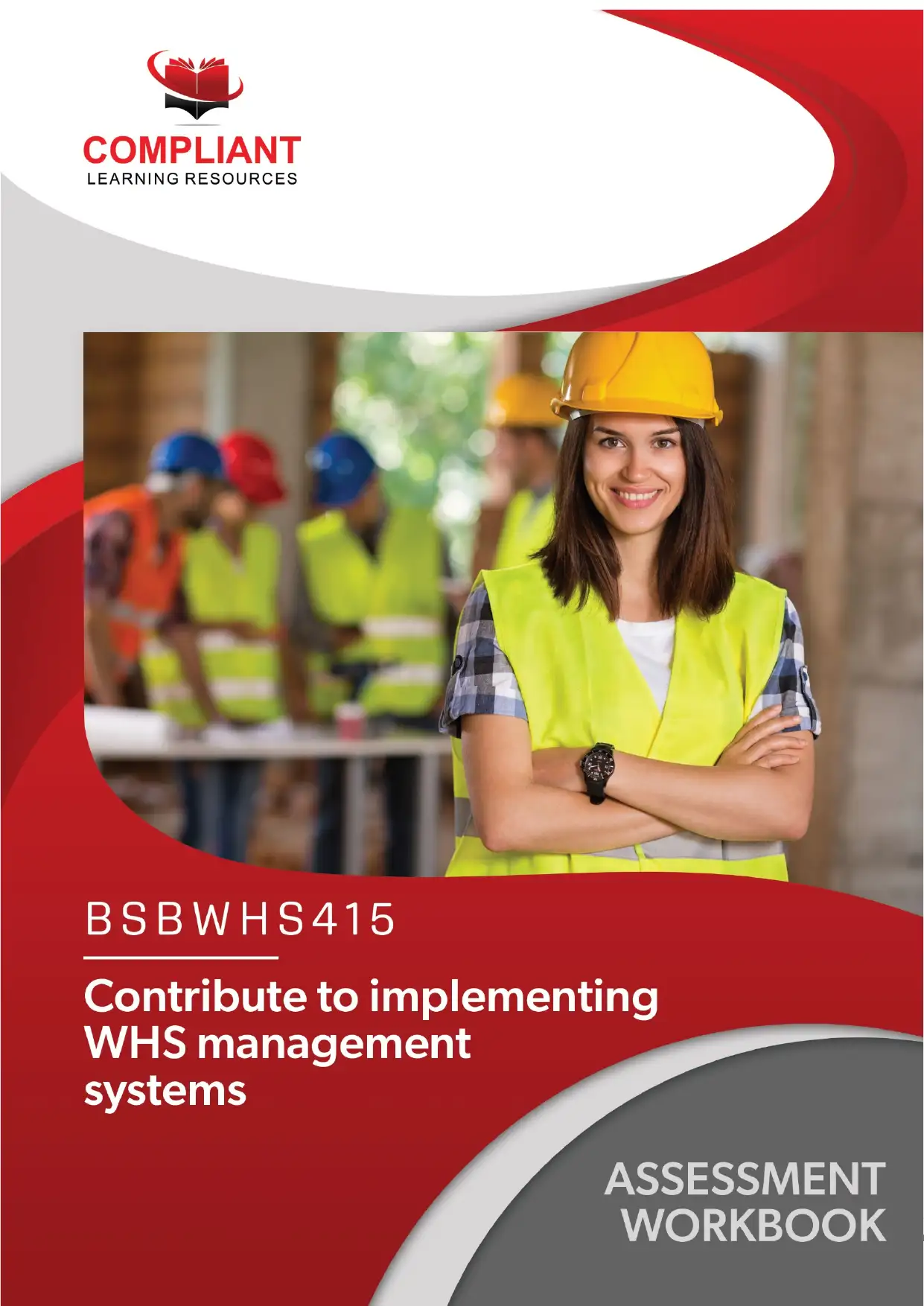
Assessment Workbook Version 1.0 Produced 30 September 2
Page 1 ©Compliant Learning Resour
Page 1 ©Compliant Learning Resour
Paraphrase This Document
Need a fresh take? Get an instant paraphrase of this document with our AI Paraphraser
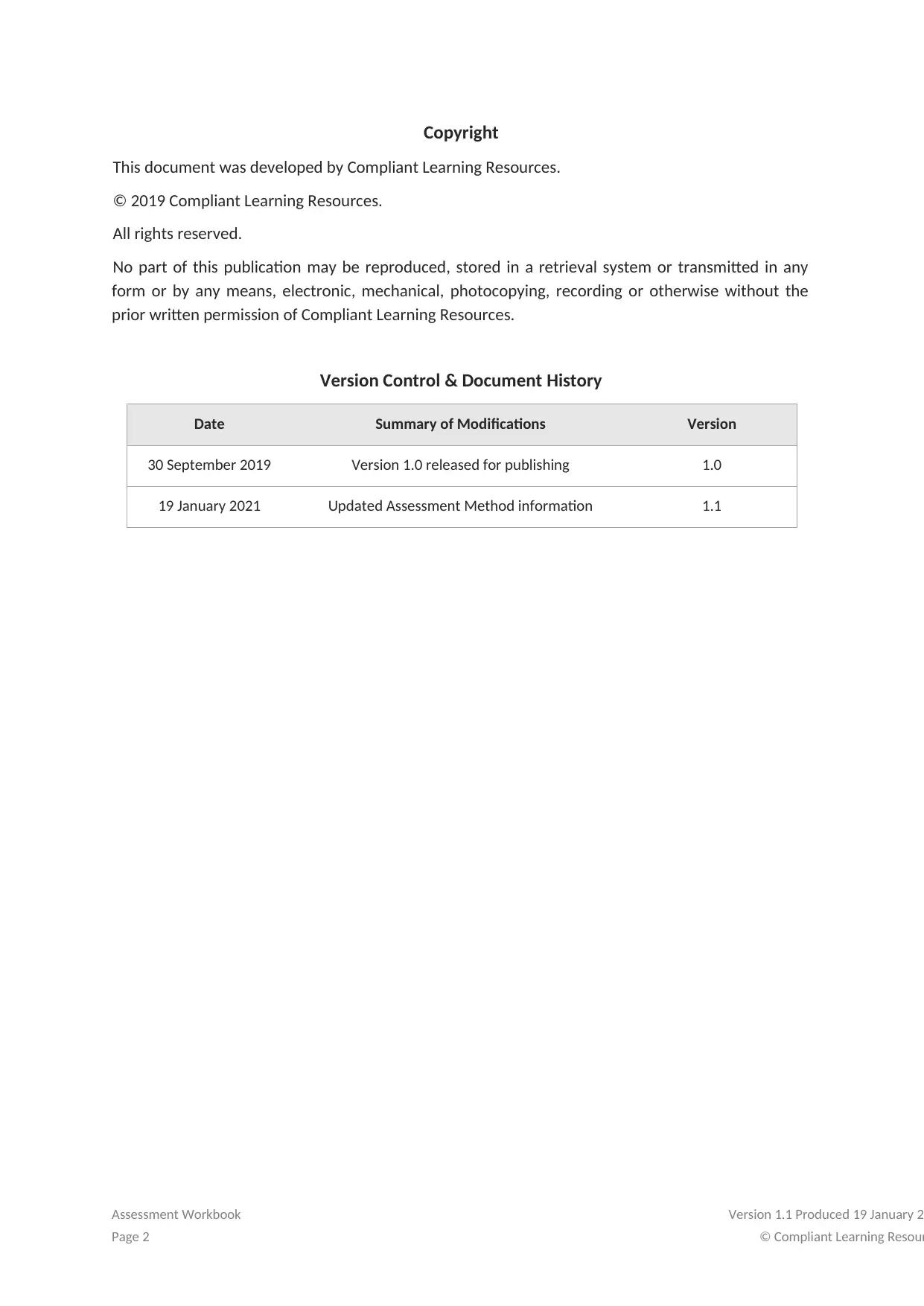
Copyright
This document was developed by Compliant Learning Resources.
© 2019 Compliant Learning Resources.
All rights reserved.
No part of this publication may be reproduced, stored in a retrieval system or transmitted in any
form or by any means, electronic, mechanical, photocopying, recording or otherwise without the
prior written permission of Compliant Learning Resources.
Version Control & Document History
Date Summary of Modifications Version
30 September 2019 Version 1.0 released for publishing 1.0
19 January 2021 Updated Assessment Method information 1.1
Assessment Workbook Version 1.1 Produced 19 January 2
Page 2 © Compliant Learning Resour
This document was developed by Compliant Learning Resources.
© 2019 Compliant Learning Resources.
All rights reserved.
No part of this publication may be reproduced, stored in a retrieval system or transmitted in any
form or by any means, electronic, mechanical, photocopying, recording or otherwise without the
prior written permission of Compliant Learning Resources.
Version Control & Document History
Date Summary of Modifications Version
30 September 2019 Version 1.0 released for publishing 1.0
19 January 2021 Updated Assessment Method information 1.1
Assessment Workbook Version 1.1 Produced 19 January 2
Page 2 © Compliant Learning Resour
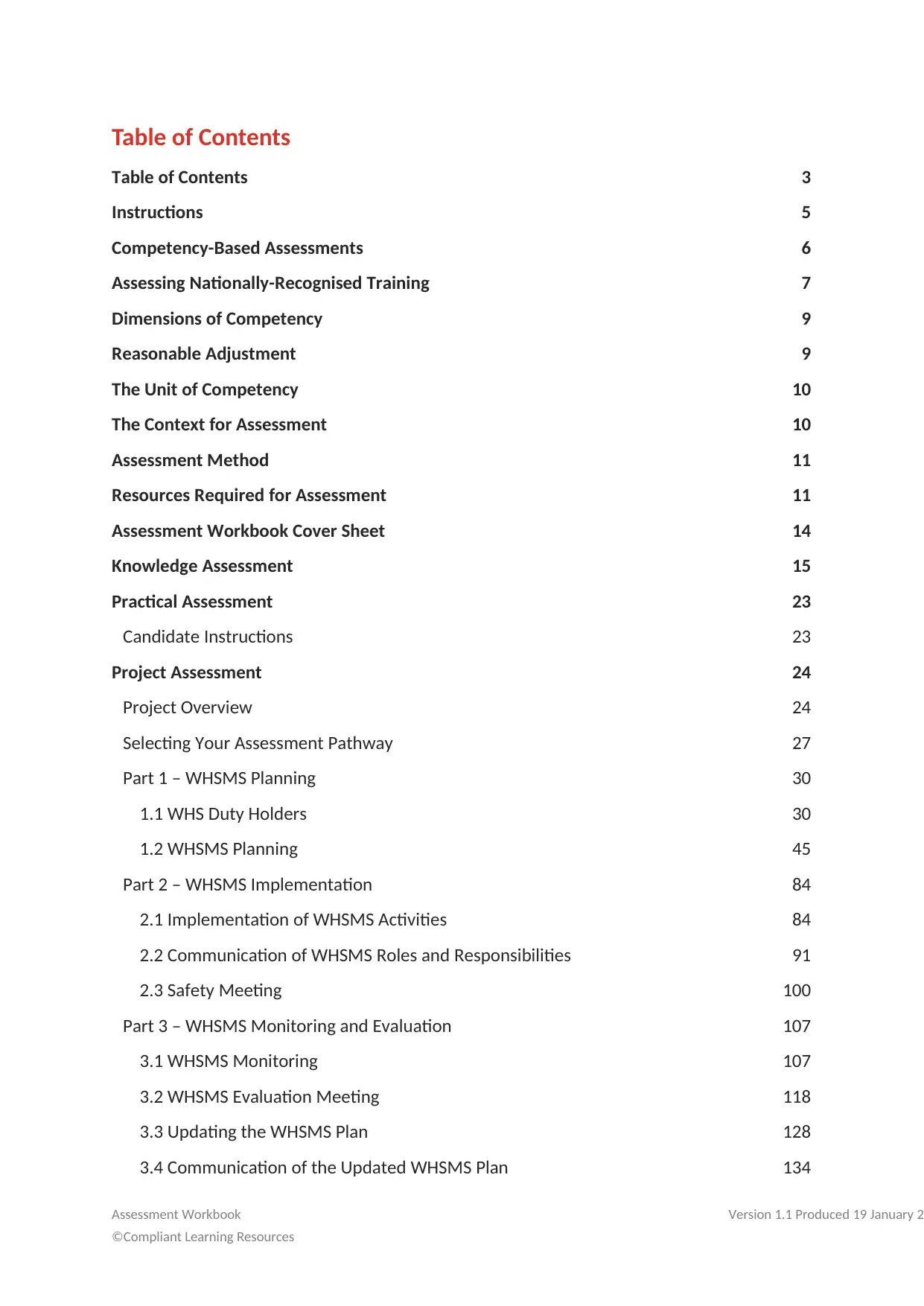
Table of Contents
Table of Contents 3
Instructions 5
Competency-Based Assessments 6
Assessing Nationally-Recognised Training 7
Dimensions of Competency 9
Reasonable Adjustment 9
The Unit of Competency 10
The Context for Assessment 10
Assessment Method 11
Resources Required for Assessment 11
Assessment Workbook Cover Sheet 14
Knowledge Assessment 15
Practical Assessment 23
Candidate Instructions 23
Project Assessment 24
Project Overview 24
Selecting Your Assessment Pathway 27
Part 1 – WHSMS Planning 30
1.1 WHS Duty Holders 30
1.2 WHSMS Planning 45
Part 2 – WHSMS Implementation 84
2.1 Implementation of WHSMS Activities 84
2.2 Communication of WHSMS Roles and Responsibilities 91
2.3 Safety Meeting 100
Part 3 – WHSMS Monitoring and Evaluation 107
3.1 WHSMS Monitoring 107
3.2 WHSMS Evaluation Meeting 118
3.3 Updating the WHSMS Plan 128
3.4 Communication of the Updated WHSMS Plan 134
Assessment Workbook Version 1.1 Produced 19 January 2
©Compliant Learning Resources
Table of Contents 3
Instructions 5
Competency-Based Assessments 6
Assessing Nationally-Recognised Training 7
Dimensions of Competency 9
Reasonable Adjustment 9
The Unit of Competency 10
The Context for Assessment 10
Assessment Method 11
Resources Required for Assessment 11
Assessment Workbook Cover Sheet 14
Knowledge Assessment 15
Practical Assessment 23
Candidate Instructions 23
Project Assessment 24
Project Overview 24
Selecting Your Assessment Pathway 27
Part 1 – WHSMS Planning 30
1.1 WHS Duty Holders 30
1.2 WHSMS Planning 45
Part 2 – WHSMS Implementation 84
2.1 Implementation of WHSMS Activities 84
2.2 Communication of WHSMS Roles and Responsibilities 91
2.3 Safety Meeting 100
Part 3 – WHSMS Monitoring and Evaluation 107
3.1 WHSMS Monitoring 107
3.2 WHSMS Evaluation Meeting 118
3.3 Updating the WHSMS Plan 128
3.4 Communication of the Updated WHSMS Plan 134
Assessment Workbook Version 1.1 Produced 19 January 2
©Compliant Learning Resources
⊘ This is a preview!⊘
Do you want full access?
Subscribe today to unlock all pages.

Trusted by 1+ million students worldwide
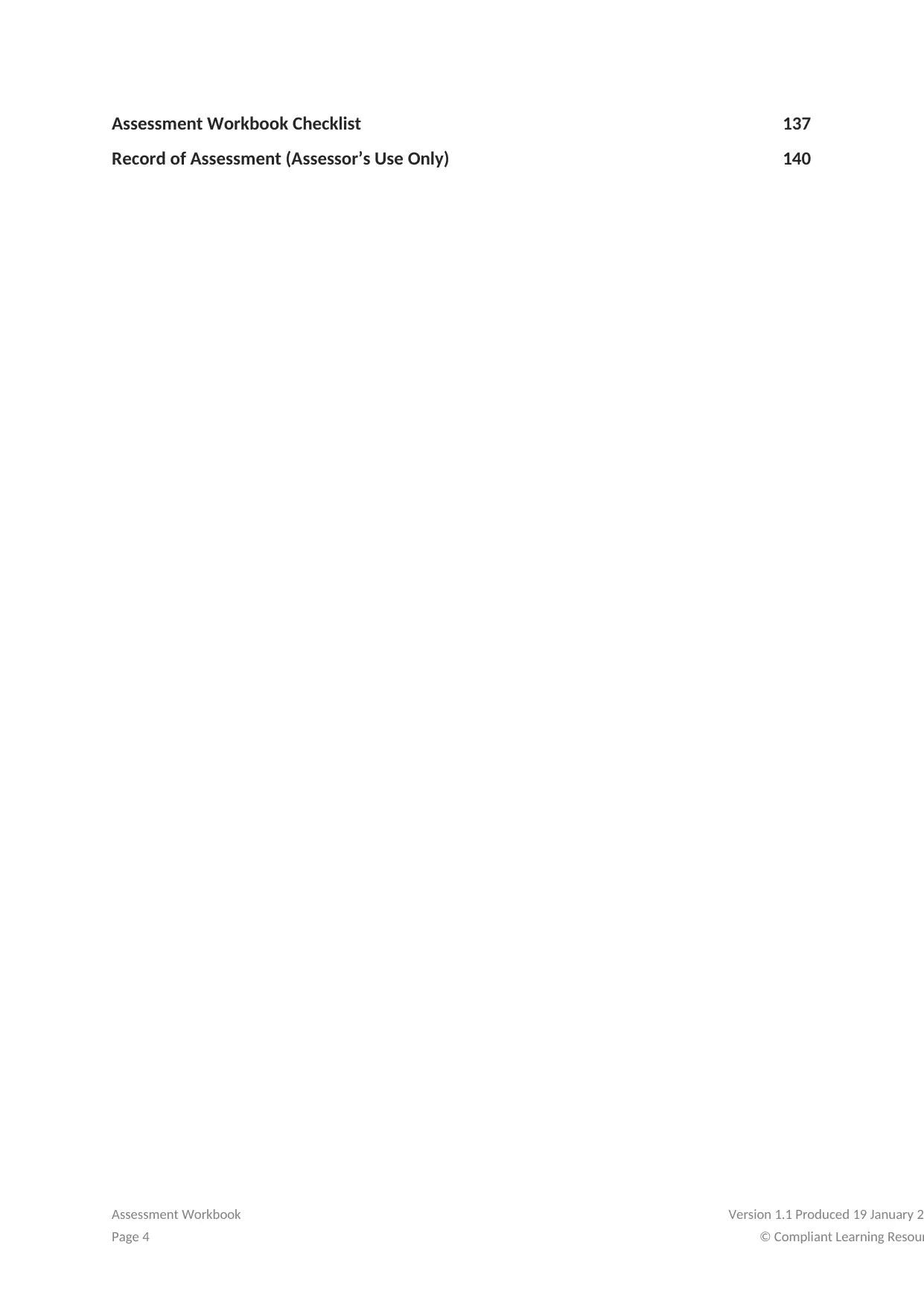
Assessment Workbook Checklist 137
Record of Assessment (Assessor’s Use Only) 140
Assessment Workbook Version 1.1 Produced 19 January 2
Page 4 © Compliant Learning Resour
Record of Assessment (Assessor’s Use Only) 140
Assessment Workbook Version 1.1 Produced 19 January 2
Page 4 © Compliant Learning Resour
Paraphrase This Document
Need a fresh take? Get an instant paraphrase of this document with our AI Paraphraser
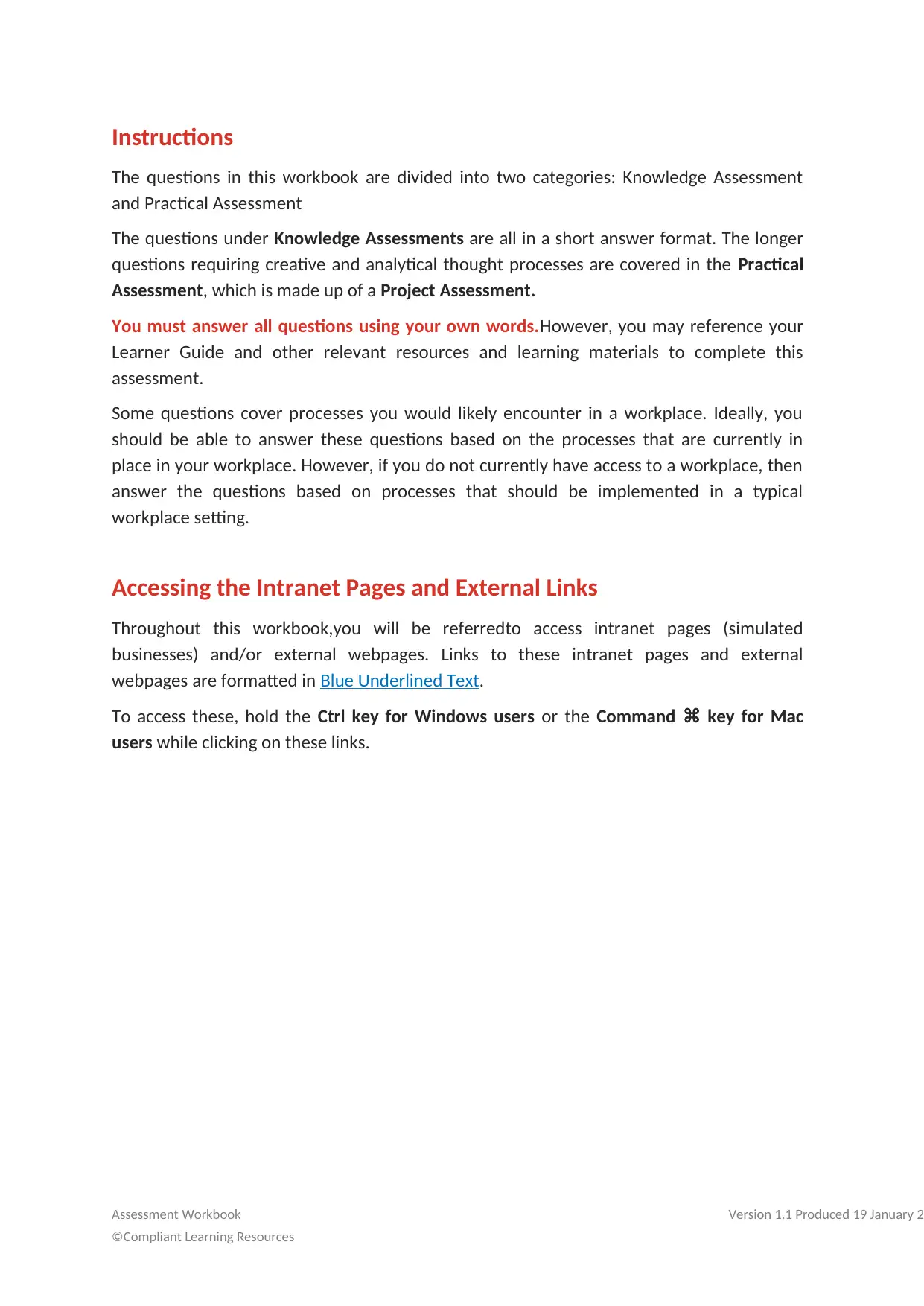
Instructions
The questions in this workbook are divided into two categories: Knowledge Assessment
and Practical Assessment
The questions under Knowledge Assessments are all in a short answer format. The longer
questions requiring creative and analytical thought processes are covered in the Practical
Assessment, which is made up of a Project Assessment.
You must answer all questions using your own words.However, you may reference your
Learner Guide and other relevant resources and learning materials to complete this
assessment.
Some questions cover processes you would likely encounter in a workplace. Ideally, you
should be able to answer these questions based on the processes that are currently in
place in your workplace. However, if you do not currently have access to a workplace, then
answer the questions based on processes that should be implemented in a typical
workplace setting.
Accessing the Intranet Pages and External Links
Throughout this workbook,you will be referredto access intranet pages (simulated
businesses) and/or external webpages. Links to these intranet pages and external
webpages are formatted in Blue Underlined Text.
To access these, hold the Ctrl key for Windows users or the Command ⌘ key for Mac
users while clicking on these links.
Assessment Workbook Version 1.1 Produced 19 January 2
©Compliant Learning Resources
The questions in this workbook are divided into two categories: Knowledge Assessment
and Practical Assessment
The questions under Knowledge Assessments are all in a short answer format. The longer
questions requiring creative and analytical thought processes are covered in the Practical
Assessment, which is made up of a Project Assessment.
You must answer all questions using your own words.However, you may reference your
Learner Guide and other relevant resources and learning materials to complete this
assessment.
Some questions cover processes you would likely encounter in a workplace. Ideally, you
should be able to answer these questions based on the processes that are currently in
place in your workplace. However, if you do not currently have access to a workplace, then
answer the questions based on processes that should be implemented in a typical
workplace setting.
Accessing the Intranet Pages and External Links
Throughout this workbook,you will be referredto access intranet pages (simulated
businesses) and/or external webpages. Links to these intranet pages and external
webpages are formatted in Blue Underlined Text.
To access these, hold the Ctrl key for Windows users or the Command ⌘ key for Mac
users while clicking on these links.
Assessment Workbook Version 1.1 Produced 19 January 2
©Compliant Learning Resources
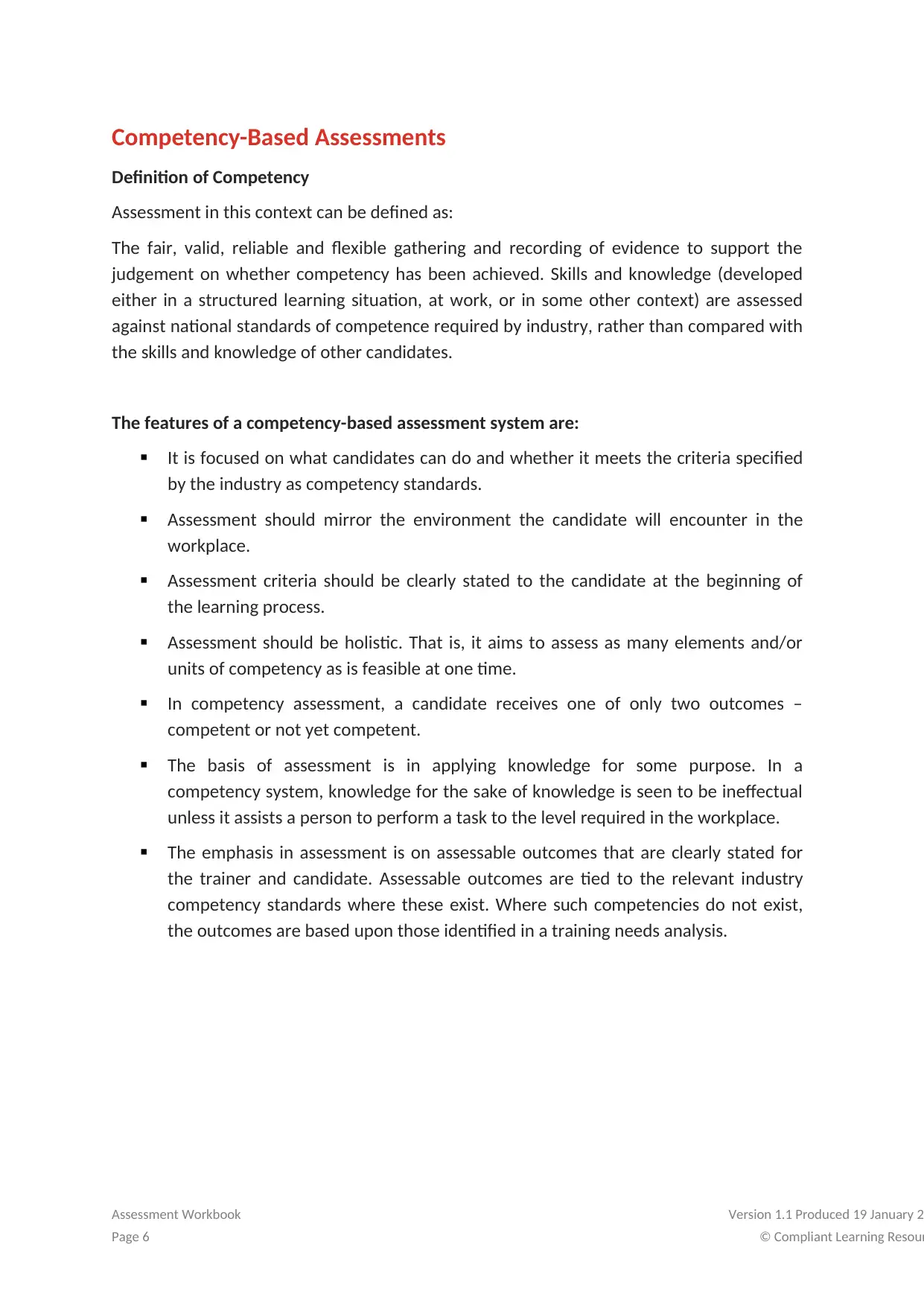
Competency-Based Assessments
Definition of Competency
Assessment in this context can be defined as:
The fair, valid, reliable and flexible gathering and recording of evidence to support the
judgement on whether competency has been achieved. Skills and knowledge (developed
either in a structured learning situation, at work, or in some other context) are assessed
against national standards of competence required by industry, rather than compared with
the skills and knowledge of other candidates.
The features of a competency-based assessment system are:
It is focused on what candidates can do and whether it meets the criteria specified
by the industry as competency standards.
Assessment should mirror the environment the candidate will encounter in the
workplace.
Assessment criteria should be clearly stated to the candidate at the beginning of
the learning process.
Assessment should be holistic. That is, it aims to assess as many elements and/or
units of competency as is feasible at one time.
In competency assessment, a candidate receives one of only two outcomes –
competent or not yet competent.
The basis of assessment is in applying knowledge for some purpose. In a
competency system, knowledge for the sake of knowledge is seen to be ineffectual
unless it assists a person to perform a task to the level required in the workplace.
The emphasis in assessment is on assessable outcomes that are clearly stated for
the trainer and candidate. Assessable outcomes are tied to the relevant industry
competency standards where these exist. Where such competencies do not exist,
the outcomes are based upon those identified in a training needs analysis.
Assessment Workbook Version 1.1 Produced 19 January 2
Page 6 © Compliant Learning Resour
Definition of Competency
Assessment in this context can be defined as:
The fair, valid, reliable and flexible gathering and recording of evidence to support the
judgement on whether competency has been achieved. Skills and knowledge (developed
either in a structured learning situation, at work, or in some other context) are assessed
against national standards of competence required by industry, rather than compared with
the skills and knowledge of other candidates.
The features of a competency-based assessment system are:
It is focused on what candidates can do and whether it meets the criteria specified
by the industry as competency standards.
Assessment should mirror the environment the candidate will encounter in the
workplace.
Assessment criteria should be clearly stated to the candidate at the beginning of
the learning process.
Assessment should be holistic. That is, it aims to assess as many elements and/or
units of competency as is feasible at one time.
In competency assessment, a candidate receives one of only two outcomes –
competent or not yet competent.
The basis of assessment is in applying knowledge for some purpose. In a
competency system, knowledge for the sake of knowledge is seen to be ineffectual
unless it assists a person to perform a task to the level required in the workplace.
The emphasis in assessment is on assessable outcomes that are clearly stated for
the trainer and candidate. Assessable outcomes are tied to the relevant industry
competency standards where these exist. Where such competencies do not exist,
the outcomes are based upon those identified in a training needs analysis.
Assessment Workbook Version 1.1 Produced 19 January 2
Page 6 © Compliant Learning Resour
⊘ This is a preview!⊘
Do you want full access?
Subscribe today to unlock all pages.

Trusted by 1+ million students worldwide
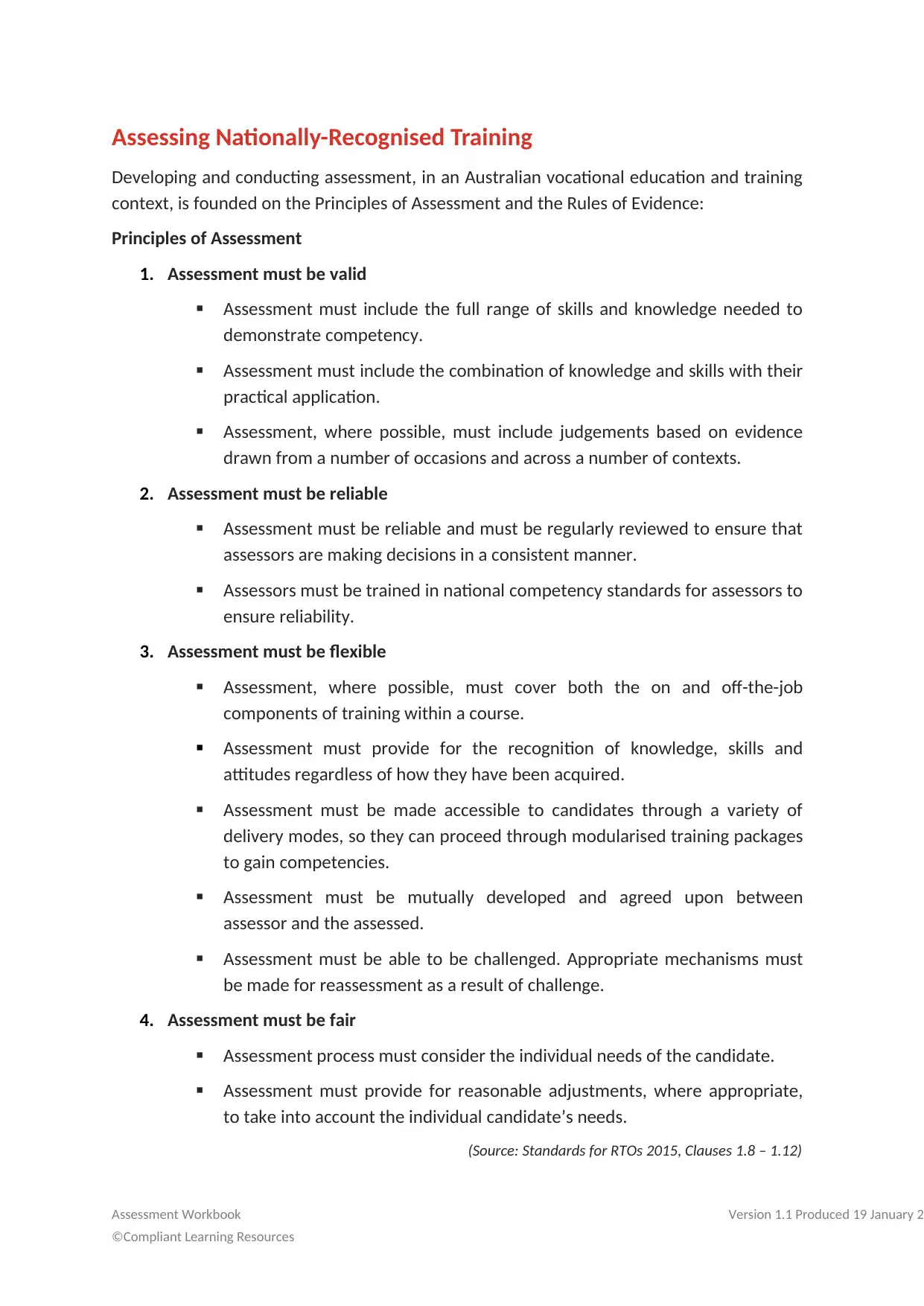
Assessing Nationally-Recognised Training
Developing and conducting assessment, in an Australian vocational education and training
context, is founded on the Principles of Assessment and the Rules of Evidence:
Principles of Assessment
1. Assessment must be valid
Assessment must include the full range of skills and knowledge needed to
demonstrate competency.
Assessment must include the combination of knowledge and skills with their
practical application.
Assessment, where possible, must include judgements based on evidence
drawn from a number of occasions and across a number of contexts.
2. Assessment must be reliable
Assessment must be reliable and must be regularly reviewed to ensure that
assessors are making decisions in a consistent manner.
Assessors must be trained in national competency standards for assessors to
ensure reliability.
3. Assessment must be flexible
Assessment, where possible, must cover both the on and off-the-job
components of training within a course.
Assessment must provide for the recognition of knowledge, skills and
attitudes regardless of how they have been acquired.
Assessment must be made accessible to candidates through a variety of
delivery modes, so they can proceed through modularised training packages
to gain competencies.
Assessment must be mutually developed and agreed upon between
assessor and the assessed.
Assessment must be able to be challenged. Appropriate mechanisms must
be made for reassessment as a result of challenge.
4. Assessment must be fair
Assessment process must consider the individual needs of the candidate.
Assessment must provide for reasonable adjustments, where appropriate,
to take into account the individual candidate’s needs.
(Source: Standards for RTOs 2015, Clauses 1.8 – 1.12)
Assessment Workbook Version 1.1 Produced 19 January 2
©Compliant Learning Resources
Developing and conducting assessment, in an Australian vocational education and training
context, is founded on the Principles of Assessment and the Rules of Evidence:
Principles of Assessment
1. Assessment must be valid
Assessment must include the full range of skills and knowledge needed to
demonstrate competency.
Assessment must include the combination of knowledge and skills with their
practical application.
Assessment, where possible, must include judgements based on evidence
drawn from a number of occasions and across a number of contexts.
2. Assessment must be reliable
Assessment must be reliable and must be regularly reviewed to ensure that
assessors are making decisions in a consistent manner.
Assessors must be trained in national competency standards for assessors to
ensure reliability.
3. Assessment must be flexible
Assessment, where possible, must cover both the on and off-the-job
components of training within a course.
Assessment must provide for the recognition of knowledge, skills and
attitudes regardless of how they have been acquired.
Assessment must be made accessible to candidates through a variety of
delivery modes, so they can proceed through modularised training packages
to gain competencies.
Assessment must be mutually developed and agreed upon between
assessor and the assessed.
Assessment must be able to be challenged. Appropriate mechanisms must
be made for reassessment as a result of challenge.
4. Assessment must be fair
Assessment process must consider the individual needs of the candidate.
Assessment must provide for reasonable adjustments, where appropriate,
to take into account the individual candidate’s needs.
(Source: Standards for RTOs 2015, Clauses 1.8 – 1.12)
Assessment Workbook Version 1.1 Produced 19 January 2
©Compliant Learning Resources
Paraphrase This Document
Need a fresh take? Get an instant paraphrase of this document with our AI Paraphraser
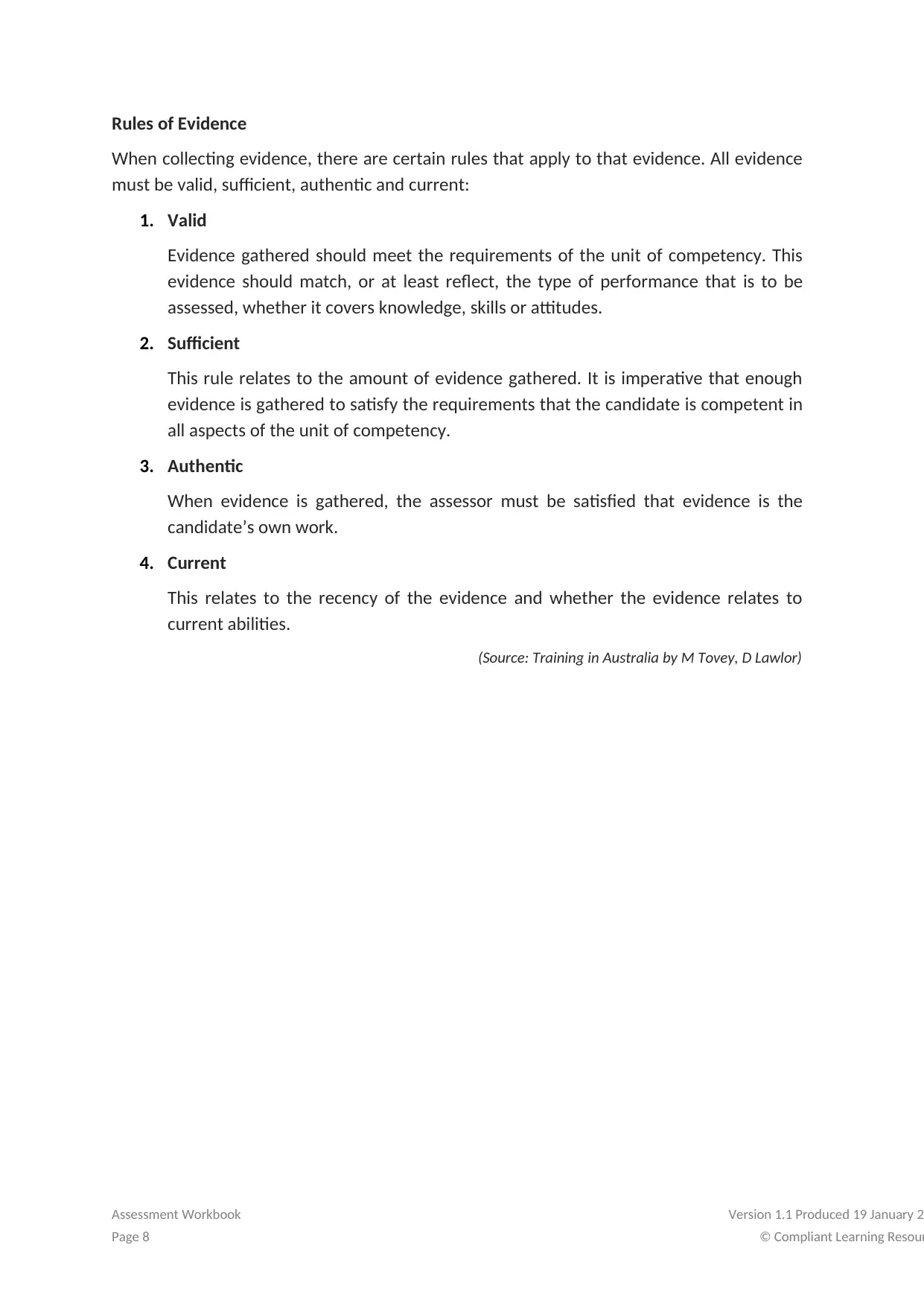
Rules of Evidence
When collecting evidence, there are certain rules that apply to that evidence. All evidence
must be valid, sufficient, authentic and current:
1. Valid
Evidence gathered should meet the requirements of the unit of competency. This
evidence should match, or at least reflect, the type of performance that is to be
assessed, whether it covers knowledge, skills or attitudes.
2. Sufficient
This rule relates to the amount of evidence gathered. It is imperative that enough
evidence is gathered to satisfy the requirements that the candidate is competent in
all aspects of the unit of competency.
3. Authentic
When evidence is gathered, the assessor must be satisfied that evidence is the
candidate’s own work.
4. Current
This relates to the recency of the evidence and whether the evidence relates to
current abilities.
(Source: Training in Australia by M Tovey, D Lawlor)
Assessment Workbook Version 1.1 Produced 19 January 2
Page 8 © Compliant Learning Resour
When collecting evidence, there are certain rules that apply to that evidence. All evidence
must be valid, sufficient, authentic and current:
1. Valid
Evidence gathered should meet the requirements of the unit of competency. This
evidence should match, or at least reflect, the type of performance that is to be
assessed, whether it covers knowledge, skills or attitudes.
2. Sufficient
This rule relates to the amount of evidence gathered. It is imperative that enough
evidence is gathered to satisfy the requirements that the candidate is competent in
all aspects of the unit of competency.
3. Authentic
When evidence is gathered, the assessor must be satisfied that evidence is the
candidate’s own work.
4. Current
This relates to the recency of the evidence and whether the evidence relates to
current abilities.
(Source: Training in Australia by M Tovey, D Lawlor)
Assessment Workbook Version 1.1 Produced 19 January 2
Page 8 © Compliant Learning Resour

Dimensions of Competency
The national concept of competency includes all aspects of work performance and not only
narrow task skills. The four dimensions of competency are:
1. Task skills
2. Task management skills
3. Contingency management skills
4. Job or role environment skills
Reasonable Adjustment
Adapted Reasonable Adjustment in teaching, learning and assessment for learners with a
disability - November 2010 - Prepared by - Queensland VET Development Centre
Reasonable adjustment in VET is the term applied to modifying the learning environment
or making changes to the training delivered to assist a candidate with a disability. A
reasonable adjustment can be as simple as changing classrooms to be closer to amenities
or installing a particular type of software on a computer for a person with vision
impairment.
Why make a reasonable adjustment?
We make reasonable adjustments in VET to make sure that candidates with a disability
have:
The same learning opportunities as candidates without a disability, and
The same opportunity to perform and complete assessments as those without a
disability.
Reasonable adjustment applied to participation in teaching, learning and assessment
activities can include:
Customising resources and assessment activities within the training package or
accredited course
Modifying the presentation medium
Learner support
Use of assistive/adaptive technologies
Making information accessible both before enrolment and during the course
Monitoring the adjustments to ensure candidate needs continue to be met
Assessment Workbook Version 1.1 Produced 19 January 2
©Compliant Learning Resources
The national concept of competency includes all aspects of work performance and not only
narrow task skills. The four dimensions of competency are:
1. Task skills
2. Task management skills
3. Contingency management skills
4. Job or role environment skills
Reasonable Adjustment
Adapted Reasonable Adjustment in teaching, learning and assessment for learners with a
disability - November 2010 - Prepared by - Queensland VET Development Centre
Reasonable adjustment in VET is the term applied to modifying the learning environment
or making changes to the training delivered to assist a candidate with a disability. A
reasonable adjustment can be as simple as changing classrooms to be closer to amenities
or installing a particular type of software on a computer for a person with vision
impairment.
Why make a reasonable adjustment?
We make reasonable adjustments in VET to make sure that candidates with a disability
have:
The same learning opportunities as candidates without a disability, and
The same opportunity to perform and complete assessments as those without a
disability.
Reasonable adjustment applied to participation in teaching, learning and assessment
activities can include:
Customising resources and assessment activities within the training package or
accredited course
Modifying the presentation medium
Learner support
Use of assistive/adaptive technologies
Making information accessible both before enrolment and during the course
Monitoring the adjustments to ensure candidate needs continue to be met
Assessment Workbook Version 1.1 Produced 19 January 2
©Compliant Learning Resources
⊘ This is a preview!⊘
Do you want full access?
Subscribe today to unlock all pages.

Trusted by 1+ million students worldwide

Assistive/Adaptive Technologies
Assistive/Adaptive technology means ‘software or hardware that has been specifically
designed to assist people with disabilities in carrying out daily activities’ (World Wide Web
Consortium - W3C). It includes screen readers, magnifiers, voice recognition software,
alternative keyboards, devices for grasping, visual alert systems, digital note takers.
IMPORTANT:
Reasonable adjustment made for collecting candidate assessment evidence must not
impact on the standard expected by the workplace, as expressed by the relevant unit(s)
of competency. For example, if the assessment were gathering evidence of the
candidate’s competency in writing, allowing the candidate to complete the assessment
verbally would not be a valid assessment method. The method of assessment used by
any reasonable adjustment must still meet the competency requirements.
The Unit of Competency
The units of competency specify the standards of performance required in the workplace.
This assessment addresses the following unit of competency:
BSBWHS415 - Contribute to implementing WHS management systems (Release 1)
1. Contribute to developing WHSMS implementation plan
2. Contribute to implementing developed plan
3. Contribute to reviewing WHSMS implementation plan
A complete copy of the above unit of competency can be downloaded from the
TGA website:
https://training.gov.au/Training/Details/BSBWHS415
The Context for Assessment
To complete the assessments in this workbook, students need to have access to their
learning materials and the Internet. The Knowledge Assessment may be completed wholly
at the candidate’s home or chosen place of study. The Practical Assessment must be
completed in a workplace or in a simulated environment.
Assessment Workbook Version 1.1 Produced 19 January 2
Page 10 © Compliant Learning Resour
Assistive/Adaptive technology means ‘software or hardware that has been specifically
designed to assist people with disabilities in carrying out daily activities’ (World Wide Web
Consortium - W3C). It includes screen readers, magnifiers, voice recognition software,
alternative keyboards, devices for grasping, visual alert systems, digital note takers.
IMPORTANT:
Reasonable adjustment made for collecting candidate assessment evidence must not
impact on the standard expected by the workplace, as expressed by the relevant unit(s)
of competency. For example, if the assessment were gathering evidence of the
candidate’s competency in writing, allowing the candidate to complete the assessment
verbally would not be a valid assessment method. The method of assessment used by
any reasonable adjustment must still meet the competency requirements.
The Unit of Competency
The units of competency specify the standards of performance required in the workplace.
This assessment addresses the following unit of competency:
BSBWHS415 - Contribute to implementing WHS management systems (Release 1)
1. Contribute to developing WHSMS implementation plan
2. Contribute to implementing developed plan
3. Contribute to reviewing WHSMS implementation plan
A complete copy of the above unit of competency can be downloaded from the
TGA website:
https://training.gov.au/Training/Details/BSBWHS415
The Context for Assessment
To complete the assessments in this workbook, students need to have access to their
learning materials and the Internet. The Knowledge Assessment may be completed wholly
at the candidate’s home or chosen place of study. The Practical Assessment must be
completed in a workplace or in a simulated environment.
Assessment Workbook Version 1.1 Produced 19 January 2
Page 10 © Compliant Learning Resour
Paraphrase This Document
Need a fresh take? Get an instant paraphrase of this document with our AI Paraphraser

Assessment Method
This workbook uses the following assessment method(s):
1. Knowledge Assessment
Written assessments to test students’ understanding of underpinning knowledge, concepts
and/or theories relevant to the units of competency included in this subject.
2. Practical Assessment
A task or activity completed according to set instructions and guidelines to meet the
requirements of the relevant units.
Resources Required for Assessment
Assessor to provide:
Assistance to the candidate undertaking the project assessment in the simulated
pathway, including but not limited to - participating in simulated meetings and
consultations with the candidate as required in the assessments, etc.
Information about work activities
The candidate will need access to:
Computer with internet and email access and a working web browser
Installed software: MS Word, Adobe Acrobat Reader
Information on WHS legislation, regulations, codes of practice, and guidance
materials.
If undertaking the Project Assessment in the workplace pathway:
Workplace that will allow you access to:
o Workplace supervisor
o At least two relevant stakeholders
Relevant stakeholders include your supervisor, WHS personnel, e.g. they have
current knowledge and skills in work health and safety management systems
(WHSMS) planning, they are representatives from management and Health
and Safety Committee (HSC), Health and Safety Representatives (HSRs),
department supervisors, and employees or contractors who are concerned
with work health and safety, or they are legal advisers and consultants in their
respective workplaces, etc.
Assessment Workbook Version 1.1 Produced 19 January 2
©Compliant Learning Resources
This workbook uses the following assessment method(s):
1. Knowledge Assessment
Written assessments to test students’ understanding of underpinning knowledge, concepts
and/or theories relevant to the units of competency included in this subject.
2. Practical Assessment
A task or activity completed according to set instructions and guidelines to meet the
requirements of the relevant units.
Resources Required for Assessment
Assessor to provide:
Assistance to the candidate undertaking the project assessment in the simulated
pathway, including but not limited to - participating in simulated meetings and
consultations with the candidate as required in the assessments, etc.
Information about work activities
The candidate will need access to:
Computer with internet and email access and a working web browser
Installed software: MS Word, Adobe Acrobat Reader
Information on WHS legislation, regulations, codes of practice, and guidance
materials.
If undertaking the Project Assessment in the workplace pathway:
Workplace that will allow you access to:
o Workplace supervisor
o At least two relevant stakeholders
Relevant stakeholders include your supervisor, WHS personnel, e.g. they have
current knowledge and skills in work health and safety management systems
(WHSMS) planning, they are representatives from management and Health
and Safety Committee (HSC), Health and Safety Representatives (HSRs),
department supervisors, and employees or contractors who are concerned
with work health and safety, or they are legal advisers and consultants in their
respective workplaces, etc.
Assessment Workbook Version 1.1 Produced 19 January 2
©Compliant Learning Resources

o Workplace information, including but not limited to:
- the organisation’s description/nature of business and relevant industry
- organisational chart, to assist you in determining the WHS duty holders
in your workplace.
- organisation’s work health and safety management system to help you
determine the different elements that need to be implemented for this
assessment, e.g. WHS policies and procedures, WHS training and
induction, WHS consultation and communication processes, safe
systems of work, risk management process, responsibilities of different
stakeholders as part of the plan, etc.
- organisation’s template and style guide for Work Health and Safety
Management System (WHSMS) plans and associated requirements
e.g. policies and procedures template, style guide to be followed when
producing workplace documents, templates for creating process
documents, etc.
- organisation’s WHSMS plan or framework and associated documents.
Associated documents include WHS process documents, safe systems of
work, risk management documents, key performance indicators (KPIs)
for the WHSMS, etc.
o Workplace policies and procedures, processes, systems and associated
documents relevant to the following:
- General work health and safety policy and procedures
- WHS consultation and participation
- Risk management
- Incident response
- Documenting and updating WHSMS plans
o Opportunities for you to contribute to the following:
- WHSMS planning, specifically, determining the different elements to be
implemented as part of the WHSMS plan and documenting at least two
WHSMS plans.
Plans that will be part of the organisation’s overall WHSMS plan include
policies and or procedures, health and safety plans, various WHS forms,
risk assessment documentation, work method statements, WHS training
and induction schedule, and other documents relevant to the
organisation’s WHSMS systems.
Assessment Workbook Version 1.1 Produced 19 January 2
Page 12 © Compliant Learning Resour
- the organisation’s description/nature of business and relevant industry
- organisational chart, to assist you in determining the WHS duty holders
in your workplace.
- organisation’s work health and safety management system to help you
determine the different elements that need to be implemented for this
assessment, e.g. WHS policies and procedures, WHS training and
induction, WHS consultation and communication processes, safe
systems of work, risk management process, responsibilities of different
stakeholders as part of the plan, etc.
- organisation’s template and style guide for Work Health and Safety
Management System (WHSMS) plans and associated requirements
e.g. policies and procedures template, style guide to be followed when
producing workplace documents, templates for creating process
documents, etc.
- organisation’s WHSMS plan or framework and associated documents.
Associated documents include WHS process documents, safe systems of
work, risk management documents, key performance indicators (KPIs)
for the WHSMS, etc.
o Workplace policies and procedures, processes, systems and associated
documents relevant to the following:
- General work health and safety policy and procedures
- WHS consultation and participation
- Risk management
- Incident response
- Documenting and updating WHSMS plans
o Opportunities for you to contribute to the following:
- WHSMS planning, specifically, determining the different elements to be
implemented as part of the WHSMS plan and documenting at least two
WHSMS plans.
Plans that will be part of the organisation’s overall WHSMS plan include
policies and or procedures, health and safety plans, various WHS forms,
risk assessment documentation, work method statements, WHS training
and induction schedule, and other documents relevant to the
organisation’s WHSMS systems.
Assessment Workbook Version 1.1 Produced 19 January 2
Page 12 © Compliant Learning Resour
⊘ This is a preview!⊘
Do you want full access?
Subscribe today to unlock all pages.

Trusted by 1+ million students worldwide
1 out of 148
Related Documents
Your All-in-One AI-Powered Toolkit for Academic Success.
+13062052269
info@desklib.com
Available 24*7 on WhatsApp / Email
![[object Object]](/_next/static/media/star-bottom.7253800d.svg)
Unlock your academic potential
Copyright © 2020–2025 A2Z Services. All Rights Reserved. Developed and managed by ZUCOL.





